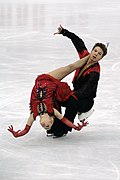It is proposed that this article be deleted because of the following concern:
If you can address this concern by improving, copyediting, sourcing, renaming, or merging the page, please edit this page and do so. You may remove this message if you improve the article or otherwise object to deletion for any reason. Although not required, you are encouraged to explain why you object to the deletion, either in your edit summary or on the talk page. If this template is removed, do not replace it . The article may be deleted if this message remains in place for seven days, i.e., after 18:01, 16 August 2025 (UTC). Find sources: "Figure skating lifts" – news · newspapers · books · scholar · JSTOR Nominator: Please consider notifying the author/project: {{ subst:proposed deletion notify |Figure skating lifts|concern=All the content in this article are in other articles ([[Pair skating#Competition requirements]] and [[Competition elements in ice dance#Dance lifts]]), and are basically synopses. Consequently, a separate article about Figure skating lifts is unnecessary.}} ~~~~ |
| Figure skating element | |
|---|---|
 Canadian ice dancers Tessa Virtue and Scott Moir perform an ice dance lift. | |
| Element name | Lift |
| Scoring abbreviation | Li |
| Disciplines | Pair skating Ice dance |
Figure skating lifts are required elements in two disciplines of figure skating: pair skating and ice dance. There are five groups of lifts in pair skating, categorized in order of increasing level of difficulty. Judges look for the following when evaluating pair lifts: speed of entry and exit; control of the woman's free leg when she is exiting out of the lift, with the goal of keeping the leg high and sweeping; the position of the woman in the air; the man's footwork; quick and easy changes of position; and the maintenance of flow throughout the lift. Twist lifts are "the most thrilling and exciting component in pair skating". [1] They can also be the most difficult movement to perform correctly. They require more strength and coordination than many other pair elements, and are usually the first or second element in a program. According to the International Skating Union (ISU), "the Woman must be caught in the air at the waist by the Man prior to landing and be assisted to a smooth landing on the ice on a backward outside edge on one foot" [2] during a twist lift. A pair lift and twist lift is required in the short program of pair skating; a well-balanced free skating program in pair skating must include lifts.
The ISU defines dance lifts as "a movement in which one of the partners is elevated with active and/or passive assistance of the other partner to any permitted height, sustained there and set down on the ice". [3] Dance lifts are delineated from pair lifts to ensure that ice dance and pair skating remain separate disciplines. After the judging system changed from the 6.0 system to the ISU Judging System (IJS), dance lifts became more "athletic, dramatic and exciting". [4] There are two types of dance lifts: short lifts, which should be done in under seven seconds; and combination lifts, which should be done in under 12 seconds. A well-balanced free dance program in ice dance must include dance lifts.


















